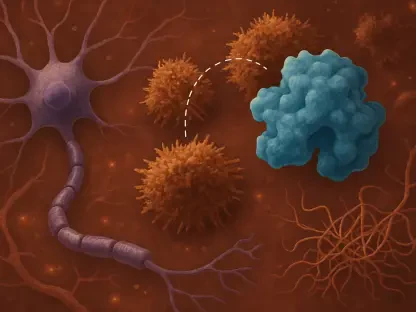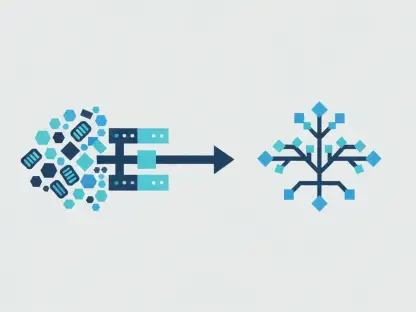Imagine a common over-the-counter pain reliever having the potential to alleviate the symptoms of a rare genetic disorder that currently lacks any formal treatment. This possibility could mark a significant breakthrough for patients who face enormous challenges and discomfort due to their conditions. Researchers have begun exploring how ibuprofen, a widely used NSAID, might offer relief for individuals suffering from MAN1B1-congenital disorder of glycosylation, a genetic disease arising from mutations in the MAN1B1 gene.
Uncharted Territories: Discovering New Uses for Existing Drugs
The Critical Role of MAN1B1 in Protein Disposal
The MAN1B1 gene holds a pivotal role in cellular function as it assists in the disposal of misfolded proteins. When mutations occur in this gene, it leads to a cascade of problems that manifest in a range of severe symptoms. Children born with these mutations often face developmental delays and distinct physical traits such as being prone to obesity and displaying exaggerated facial features. Furthermore, they experience behavioral issues like aggression, compounding the difficulties already imposed by their physical symptoms. This interconnected set of challenges highlights the urgent need for viable treatment options.
In the absence of targeted therapies, the standard approach for treating MAN1B1-congenital disorder has been largely symptomatic, focusing on individual symptoms without addressing the root cause. Drug repurposing offers a promising avenue, as it leverages existing medications that already have established safety profiles. This approach significantly shortens the time required for bringing a therapy to market compared to the traditional drug development pipeline. The research spearheaded by geneticist Clement Chow and his team at the University of Utah emphasizes the importance of this strategy in finding immediate solutions for those suffering from rare genetic diseases.
Experimenting with Fruit Flies to Identify Potential Treatments
In a bold move to identify potential treatments, the researchers conducted their initial experiments using fruit flies. The simplicity of this model organism combined with its genetic similarities to humans makes it an ideal candidate for preliminary studies. By introducing mutations in the MAN1B1 gene in the eyes of the fruit flies, the team noted a striking transformation. The typically large, red compound eyes turned small and rough, providing a clear and observable phenotype for assessing the impact of various drugs.
Testing around 1,500 approved drugs, the researchers discovered that 51 were able to restore the eyes to their normal appearance. Among these, nine were found to be NSAIDs, with ibuprofen showing particular promise. The key to ibuprofen’s effectiveness lies in its ability to inhibit COX1 and COX2 enzymes, which play a role in inflammation. In fruit flies with the MAN1B1 mutation, the activity of these enzymes was unusually high, but was notably reduced upon ibuprofen treatment. This reduction not only restored the eye shape but also mirrored the therapeutic effects desired for correcting other mutation-induced abnormalities.
From Laboratory to Real-world Applications
Initial Trials with Ibuprofen in Human Subjects
Buoyed by the encouraging results from their preclinical studies, the researchers moved forward with cautious optimism to test the effects of ibuprofen on human subjects. Three children with MAN1B1-congenital disorder of glycosylation were involved in an initial low-dose ibuprofen treatment regimen. The primary objective of this phase was to assess the safety and observe any therapeutic benefits in a controlled environment. While the results are still in the early stages, the preliminary responses have been promising and provide a solid foundation for further exploration.
These initial observations suggest that ibuprofen may help in reducing inflammation and possibly moderating some of the genetic disorder’s symptoms. This potential breakthrough is not merely a step forward in the treatment of MAN1B1-congenital disorder but also a testament to the power of drug repurposing. By investigating existing medications, researchers have the opportunity to identify new and effective treatments without the extensive time and financial investment required to develop new drugs from scratch.
The Future of Drug Repurposing for Rare Diseases
Imagine an everyday over-the-counter pain reliever having the capacity to ease the symptoms of a rare genetic disorder that currently has no official treatment. This possibility could be a major breakthrough for patients who endure immense challenges and discomfort due to their conditions. Researchers are investigating whether ibuprofen, a common nonsteroidal anti-inflammatory drug (NSAID), might offer relief for individuals affected by MAN1B1-congenital disorder of glycosylation. This genetic disease is caused by mutations in the MAN1B1 gene. If ibuprofen proves effective, it would not only provide hope for those with this specific disorder but could also pave the way for new therapeutic approaches for other similar conditions. By repurposing a readily available drug, researchers might fast-track a viable solution for patients who desperately need it, significantly improving their quality of life. This line of investigation holds promise for transforming the way certain rare diseases are managed in the future.









